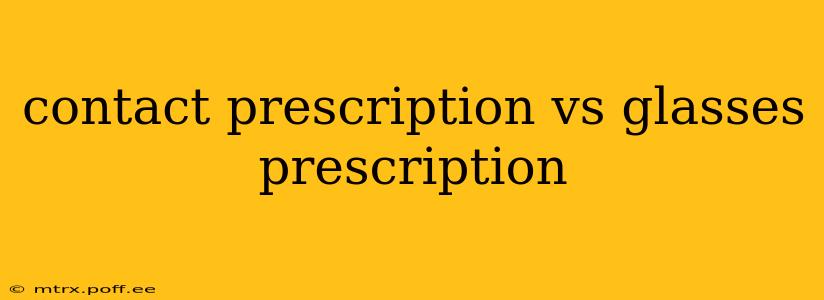Choosing between contact lenses and glasses often comes down to personal preference, lifestyle, and visual needs. However, a crucial factor to consider is that your prescription for contacts and glasses will likely be different. While both correct your vision, the measurements and terminology used differ due to the unique way each sits on or in your eye. This article will clarify the key distinctions between contact and glasses prescriptions and answer common questions.
What's the Difference Between Contact Lens and Glasses Prescriptions?
The primary difference lies in the measurement of the power required to correct your vision. Glasses sit a distance away from your eye, whereas contact lenses rest directly on the cornea. This difference in distance necessitates a slightly adjusted prescription.
Key Differences Explained:
-
Vertex Distance: This is the most significant difference. Vertex distance is the distance between the front surface of the eye and the correcting lens (glasses). This distance impacts the refractive power needed. For glasses, the vertex distance is typically around 12-14mm. With contact lenses, the distance is practically zero. This means that the power for contact lenses needs to be adjusted to compensate for this difference in distance. Opticians use complex calculations to convert a glasses prescription to a contact lens prescription and vice versa.
-
Pupillary Distance (PD): While both prescriptions require a PD measurement (the distance between the centers of your pupils), the application differs. For glasses, this ensures the lenses are properly aligned. For contacts, it's less critical, though some contact lens fitting processes may use it to better understand your eye alignment and how the lenses interact with your vision.
-
Lens Type: The type of lens (e.g., spherical, toric, multifocal) will be specified on both prescriptions, but the specific parameters for the same type of lens might differ slightly between contact and glasses prescriptions due to the vertex distance and the way the lens interacts with your eye.
What are the Measurements in a Contact Lens Prescription?
A contact lens prescription usually includes:
-
Sphere (SPH): Corrects for nearsightedness (myopia) or farsightedness (hyperopia). Similar to glasses, but numerically adjusted.
-
Cylinder (CYL): Corrects for astigmatism (irregular corneal shape). Again, similar to glasses but numerically adjusted.
-
Axis (AX): Specifies the orientation of the astigmatism correction. This is identical to glasses prescriptions.
-
Base Curve (BC): This is the curvature of the back surface of the contact lens. This is crucial for proper fit and comfort, and it's not found in glasses prescriptions.
-
Diameter (DIA): This refers to the overall diameter of the contact lens. It influences comfort and proper fit on the eye, and is also not present in glasses prescriptions.
-
Lens Type: This specifies the material of the contact lens (e.g., silicone hydrogel, hydrogel) as well as the type of lens for vision correction. This is crucial for proper usage, comfort, and eye health.
Can I Use My Glasses Prescription for Contact Lenses?
No. You should never attempt to use your glasses prescription for contact lenses or vice versa. The differences in vertex distance, as explained above, necessitate a separate and specifically calculated prescription for each. Using the wrong prescription could lead to eye strain, discomfort, and potentially more serious complications.
Why Does My Contact Lens Prescription Differ from My Glasses Prescription?
The difference stems from the varying distances between the correcting lens and the cornea. As mentioned earlier, the vertex distance is significantly different between glasses and contacts, requiring a recalculation of the refractive power to achieve optimal vision correction.
How Often Should I Get My Eyes Examined for Contacts and Glasses?
Regular eye exams are essential for both glasses and contact lenses. Your eye care professional will assess your vision, check for any changes, and update your prescription accordingly. Annual check-ups are generally recommended, but your ophthalmologist or optometrist may suggest more frequent visits depending on your individual needs and health conditions.
Conclusion:
Understanding the differences between contact lens and glasses prescriptions is critical for achieving optimal vision correction and maintaining good eye health. Always consult your eye care professional to obtain accurate and appropriate prescriptions for both glasses and contact lenses. They are trained to perform the necessary calculations and ensure your lenses fit correctly and provide you with the best possible vision.
